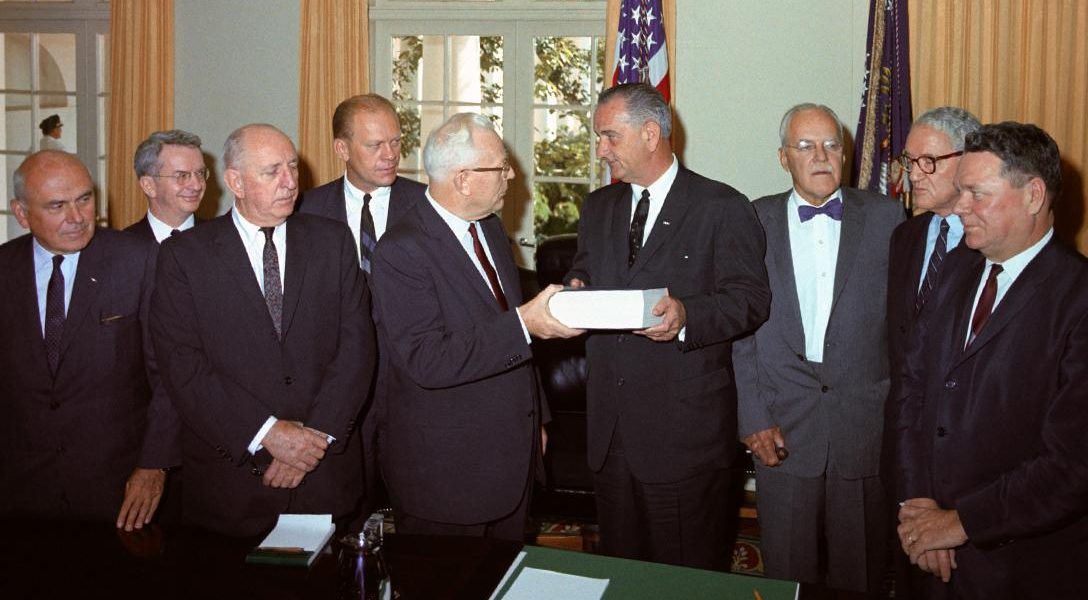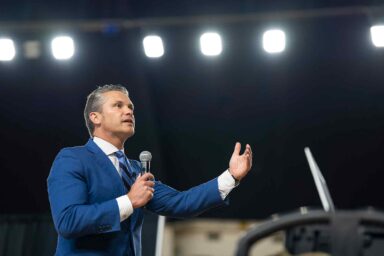New Book on CIA Master-Plotter Dulles, Sneak Peek: Part 2
Prime Suspect in JFK Hit Leads Investigation
In this second excerpt from the new book The Devil’s Chessboard, by David Talbot, we examine the formation and activities of the Warren Commission. And we note the central role in guiding the Commission’s “probe” of none other than Allen Dulles — a professional coup planner who might under normal circumstances have been considered a prime suspect.
No one can possibly understand the precarious state of American democracy today without scrutinizing the often secret path the country was taken on by those in power from the 1950s to the present.
Among the elemental figures in forging that path was Allen Dulles.
He was the most powerful, and, it appears — the most sinister — director of the Central Intelligence Agency. Given that outfit’s history, that’s some accomplishment.
Dulles’s job, simply put, was to hijack the US government to benefit the wealthy.
Studying how this worked is a worthwhile pursuit. That’s why we decided to excerpt a few parts of David Talbot’s new Dulles biography, The Devil’s Chessboard.
In part one of our excerpts, we looked at indications that Lee Harvey Oswald was no rogue “lone nut” but in fact a man with strong connections to the American national security apparatus. We also looked at Allen Dulles’s highly suspicious behavior around the time of the assassination — a time when he was ostensibly in retirement, having been fired two years earlier by President Kennedy. And we saw how determined Dulles was in advancing the notion that Oswald had been Kennedy’s killer, and had acted alone.
In the excerpt below, we focus on the Warren Commission, the body “above suspicion” that was supposed to investigate Kennedy’s death and report its findings to the public. We see the irrepressible Allen Dulles, who should by almost any standard have been considered a possible suspect for a role in the assassination, instead appointed to the Commission. And we see how he became the leading figure in guiding the “probe,” along with a network of individuals whose loyalties were clearly to him and to the American establishment, but certainly not to the truth — or to the late president.
–WhoWhatWhy Introduction by Russ Baker.
Second part of compressed Excerpt of Chapter 20, “For the Good of the Country” from The Devil’s Chessboard. Allen Dulles, the CIA, and the Rise of the American Secret Government. HarperCollins Publishers, 2015.
“Allen Dulles had a lot to hide.”
How did Allen Dulles — a man fired by President Kennedy under bitter circumstances — come to oversee the investigation into his murder?
This crucial historical question has been the subject of misguided speculation for many years. The story apparently began with Lyndon Johnson, a man not known for his devotion to the truth. It has been repeated over time by various historians, including Johnson biographer Robert Caro, who one would think would be more skeptical, considering the exhaustive detail with which he documented LBJ’s habitual deceit in his multivolume work.
In his 1971 memoir, Johnson wrote that he appointed Dulles and John McCloy to the Warren Commission because they were “the two men Bobby Kennedy asked me to put on it.” With Bobby safely dead by 1971, LBJ clearly felt that he could get away with this one. But the idea that LBJ would huddle with the man he considered his rival and tormentor, in order to discuss the politically sensitive composition of the commission, is ludicrous.
The Warren Commission’s inquiry had the ability to shake the new Johnson presidency — and the US government itself — to their very core. In making his choices for the commission, Johnson later wrote, he sought “men who were known to be beyond pressure and above suspicion.”
What LBJ really wanted was men who could be trusted to close the case and put the public’s suspicions to rest. The Warren Commission was not established to find the truth but to “lay the dust” that had been stirred up in Dallas, as McCloy stated — “dust not only in the United States, but all over the world.”
Equally preposterous is the notion that Bobby Kennedy would nominate Dulles and McCloy — two men who had fallen out with President Kennedy while serving on his national security team — to investigate his brother’s murder. Like Dulles, whose former agency Bobby immediately suspected of a role in the assassination, McCloy was a Cold War hard-liner…
McCloy, who had served as chairman of Chase Manhattan before David Rockefeller moved into the bank’s leadership role, was closely aligned with Rockefeller interests. After leaving the Kennedy administration, McCloy joined a Wall Street law firm where he represented anti-Kennedy oilmen Clint Murchison and Sid Richardson, with whom he had done business since his days at Chase Manhattan.
It was the national security establishment, not Bobby Kennedy, that advised the new president to put Dulles and McCloy on the Warren Commission. And Johnson — finely tuned to the desires of the men who had put him in the Oval Office — wisely obliged them.
The Dulles camp itself made no bones about the fact that the Old Man aggressively lobbied to get appointed to the commission. Dick Helms later told historian Michael Kurtz that he “personally persuaded” Johnson to appoint Dulles. According to Kurtz, Dulles and Helms “wanted to make sure no agency secrets came out during the investigation…. And, of course, if Dulles was on the commission, that would ensure the agency would be safe. Johnson felt the same way—he didn’t want the investigation to dig up anything strange.”
Dulles tried to establish the framework for the inquiry early on by handing the other commission members copies of a book titled The Assassins by Robert J. Donovan, a Washington journalist. Donovan’s history of presidential assassins argued that these dramatic acts of violence were the work of solitary fanatics, not “organized attempts to shift political power from one group to another.”
William Corson, a former Marine Corps officer and Navy intelligence agent who was close to Dulles, confirmed that the spymaster pulled strings to get on the Warren Commission. He “lobbied hard for the job,” recalled Corson, who had commanded young Allen Jr. in the Korean War. After he took his place on the commission, Dulles recruited Corson to explore the Jack Ruby angle. After spending months pursuing various leads, Corson eventually concluded that he had been sent on a wild-goose chase. “It is entirely possible I was sent on an assignment which would go nowhere…. Allen Dulles had a lot to hide.”
Among those urging Johnson to give Dulles the Warren Commission job were establishment allies like Secretary of State Dean Rusk, former president of the Rockefeller Foundation. These same voices were raised on behalf of McCloy. In fact, the commission was, from the very beginning, an establishment creation. It was sold to an initially reluctant LBJ by the most influential voices of the Washington power structure, including Joe Alsop — the CIA’s ever-dependable mouthpiece — and the editorial czars of The Washington Post and The New York Times.
Johnson wanted the investigation handled by officials in Texas, where he felt more in control, instead of by a “bunch of carpetbaggers.” But in a phone call to the White House on the morning of November 25, Alsop deftly maneuvered Johnson into accepting the idea of a presidential commission made up of nationally renowned figures “beyond any possible suspicion.”
When Johnson clung to his idea of a Texas investigation, the sophisticated Alsop set him straight, as if lecturing a country simpleton. “My lawyers, though, Joe, tell me that the White House — the president — must not inject himself into local killings,” LBJ said, almost pleadingly. “I agree with that,” Alsop said as he smoothly cut him off, “but in this case it does happen to be the killing of the president.”
Dulles immediately accepted Johnson’s request to join the commission when the president phoned him on the evening of November 29. “I would like to be of any help,” Dulles told Johnson, though he did feel compelled to at least raise the propriety of appointing a former CIA director who was known to have a troubled relationship with the deceased president:
“And you’ve considered the work of my previous work and my previous job?” Dulles asked inelegantly. “I sure have,” LBJ replied, “and we want you to do it. That’s that…. You always do what is best for your country. I found that out about you a long time ago.”
The Warren Commission was named after Supreme Court chief justice Earl Warren, the distinguished jurist President Johnson strong-armed into chairing the JFK inquest. But as attorney Mark Lane — one of the first critics of the lone-gunman theory — later observed, it should have been called the “Dulles Commission,” considering the spymaster’s dominant role in the investigation. In fact, Dulles was Johnson’s first choice to chair the commission, but LBJ decided that he needed Warren at the helm to deflect liberal criticism of the official inquiry…
Dulles tried to establish the framework for the inquiry early on by handing the other commission members copies of a book titled The Assassins by Robert J. Donovan, a Washington journalist. Donovan’s history of presidential assassins argued that these dramatic acts of violence were the work of solitary fanatics, not “organized attempts to shift political power from one group to another.” It was quickly pointed out to Dulles that John Wilkes Booth, who shot Lincoln as part of a broader Confederate plot to decapitate the federal government, rather famously contradicted Donovan’s theory. But, undeterred, Dulles continued to push the commission to keep a tight frame on Oswald.
Dulles offered that he would like to get these aspects of the inquiry “into the hands of the CIA as soon as possible to explain the Russian parts.” Senator Russell, long used to dealing with the intelligence community, reacted skeptically. “I think you’ve got more faith in them than I have. I think they’ll doctor anything they hand to us.”
Dulles was a whirlwind of activity, especially outside the hearing room, where he deftly maneuvered to keep the investigation on what he considered the proper track…. There was no detail too small for Dulles to bring to the chief counsel’s attention. “A great deal of the description of the motorcade and the shooting will be unclear unless we have a street map and, if possible, a photo taken from the sixth floor window,” Dulles wrote Rankin in a July 1964 memo. “Is this possible?” Dulles was particularly eager to explore any leads suggesting Oswald might be a Soviet spy — a soon discredited idea that Angleton would nonetheless keep promoting for the rest of his life.
Peculiar Behavior of Security Agencies
Despite Dulles’s efforts to keep the commission away from any hints of a domestic conspiracy, from time to time uncomfortable questions along these lines cropped up. During an executive session convened by the panel on December 16, 1963, Warren raised an especially sensitive matter — the mysterious failure of the country’s security agencies to keep close watch on someone with Oswald’s background. [Note from WhoWhatWhy editor: For an eerie parallel in Tamerlan Tsarnaev, the purported mastermind of the Boston Marathon bombing, see this.]
How, for instance, did a defector simply stroll into the US immigration office in New Orleans — as he did the previous summer — and obtain a passport to return to Russia? “That seems strange to me,” Warren remarked.
Actually, passports were rather easy to obtain, Dulles observed. When the discussion turned to the puzzling ease with which Oswald got permission to return to the United States with his Russian wife, Dulles offered that he would like to get these aspects of the inquiry “into the hands of the CIA as soon as possible to explain the Russian parts.”
Senator Russell, long used to dealing with the intelligence community, reacted skeptically. “I think you’ve got more faith in them than I have. I think they’ll doctor anything they hand to us.”
Russell was edging painfully close to the fundamental problem at the core of the Warren panel’s impossible mission. How could the board run a credible inquest when it had limited investigative capability of its own and was largely dependent on the FBI and the other security agencies for its evidence — agencies that were clearly implicated in the failure to protect the president?
The Warren Commission was, in fact, so thoroughly infiltrated and guided by the security services that there was no possibility of the panel pursuing an independent course. Dulles was at the center of this subversion. During the commission’s ten-month-long investigation, he acted as a double agent, huddling regularly with his former CIA associates to discuss the panel’s internal operations.
NEXT: Part 3. For part 1, go here.
Related front page panorama photo credit: President Kennedy presenting the National Security Medal to Allen Dulles in 1961 (CIA / Wikimedia), Allen Dulles at desk (CIA.GOV), Mohammad Mosaddegh – former prime minister of Iran (Unknown / Wikimedia) – Jacobo Árbenz 25th President of Guatemala (Gobierno de Guatemala; Escuela Politécnica de Guatemala / Wikimedia), Fidel Castro (Library of Congress / Wikimedia), CIA floor seal (CIA.GOV)



